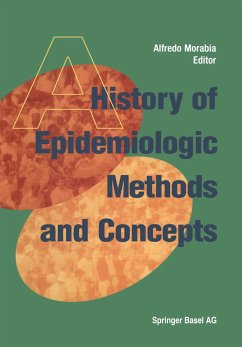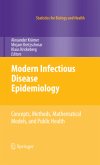Methods, just as diseases or scientists, have their own history. It is important for scientists to be aware of the genesis of the methods they use and of the context in which they were developed.
A History of Epidemiologic Methods and Concepts is based on a collection of contributions which appeared in "SPM International Journal of Public Health", starting in January 2001. The contributions focus on the historical emergence of current epidemiological methods and their relative importance at different points in time, rather than on specific achievements of epidemiology in controlling plagues such as cholera, tuberculosis, malaria, typhoid fever, or lung cancer. The papers present the design of prospective and retrospective studies, and the concepts of bias, confounding, and interaction. The compilation of articles is complemented by an introduction and comments by Prof. Alfredo Morabia which puts them in the context of current epidemiological research.
A History of Epidemiologic Methods and Concepts is based on a collection of contributions which appeared in "SPM International Journal of Public Health", starting in January 2001. The contributions focus on the historical emergence of current epidemiological methods and their relative importance at different points in time, rather than on specific achievements of epidemiology in controlling plagues such as cholera, tuberculosis, malaria, typhoid fever, or lung cancer. The papers present the design of prospective and retrospective studies, and the concepts of bias, confounding, and interaction. The compilation of articles is complemented by an introduction and comments by Prof. Alfredo Morabia which puts them in the context of current epidemiological research.
"Morabia's essay is fascinating. He is one of the very few practicing epidemiologists with a deep interest in the history of epidemiologic methods. The particular combination of his interests gives a special credibility to his essay, which describes how epidemiologic thinking has developed from the 18th century around two key ideas: concepts concerned with populations and group comparisons - the hallmarks of modern epidemiology." -- Bulletin of the World Health Organisation
"Morabia's approach is didactic, combining historical snippets with lessons on epidemiology. (American Journal of Epidemiology
...one of those few books whose reading is 'pleasantly unavoidable'... Very likely to become one of the most important epidemiological books published in the present decade." -- European Epidemiology Federation
"Morabia's approach is not only highly educational, but also a gripping read and should fascinate everybody who is concerned with epidemiology, public health, or history of medicine. Furthermore, this book will certainly be inevitable for teachers and students of public health since it offers a great variety of educational material for courses in medicine and epidemiology. Taken together, this book is highly valuable and will hopefully soon become a modern classic." -- Biometrics
"Morabia's approach is didactic, combining historical snippets with lessons on epidemiology. (American Journal of Epidemiology
...one of those few books whose reading is 'pleasantly unavoidable'... Very likely to become one of the most important epidemiological books published in the present decade." -- European Epidemiology Federation
"Morabia's approach is not only highly educational, but also a gripping read and should fascinate everybody who is concerned with epidemiology, public health, or history of medicine. Furthermore, this book will certainly be inevitable for teachers and students of public health since it offers a great variety of educational material for courses in medicine and epidemiology. Taken together, this book is highly valuable and will hopefully soon become a modern classic." -- Biometrics
Morabia's essay is fascinating. He is one of the very few practicing epidemiologists with a deep interest in the history of epidemiologic methods. The particular combination of his interests gives a special credibility to his essay, which describes how epidemiologic thinking has developed from the 18th century around two key ideas: concepts concerned with populations and group comparisons - the hallmarks of modern epidemiology. (Bulletin of the World Health Organisation)
Morabia's approach is didactic, combining historical snippets with lessons on epidemiology. (American Journal of Epidemiology)
...one of those few books whose reading is 'pleasantly unavoidable'... Very likely to become one of the most important epidemiological books published in the present decade. (European Epidemiology Federation)
Morabia's approach is not only highly educational, but also a gripping read and should fascinate everybody who is concerned with epidemiology, public health, or history of medicine. Furthermore, this book will certainly be inevitable for teachers and students of public health since it offers a great variety of educational material for courses in medicine and epidemiology. Taken together, this book is highly valuable and will hopefully soon become a modern classic. (Biometrics)
Morabia's approach is didactic, combining historical snippets with lessons on epidemiology. (American Journal of Epidemiology)
...one of those few books whose reading is 'pleasantly unavoidable'... Very likely to become one of the most important epidemiological books published in the present decade. (European Epidemiology Federation)
Morabia's approach is not only highly educational, but also a gripping read and should fascinate everybody who is concerned with epidemiology, public health, or history of medicine. Furthermore, this book will certainly be inevitable for teachers and students of public health since it offers a great variety of educational material for courses in medicine and epidemiology. Taken together, this book is highly valuable and will hopefully soon become a modern classic. (Biometrics)








